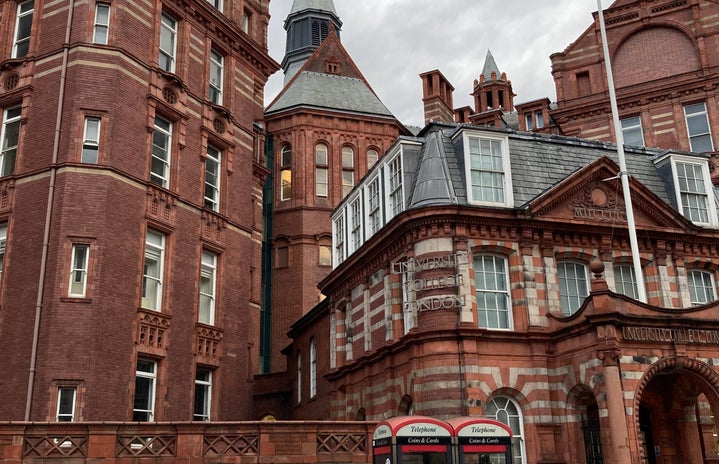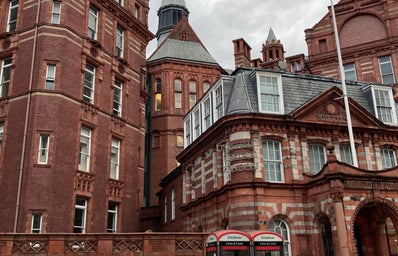How much do you know about important historic women who went to UCL?
Most of us have heard over and over that the likes of Alexander Graham Bell and Christopher Nolan went to UCL. But how many historic women are featured on famous alumni lists?
Women have always made valuable contributions to the world through writing, research, art, and activism. However, their stories are often seen as unworthy of amplifying in comparison to their male contemporaries. This article will explore the lives of three historic women who studied at UCL – Amy Nimr, Eileen Gray, and Patience Darton.
The Artist: Amy Nimr
Amy Nimr (1898–1974) was an Egyptian-born artist and writer. Nimr was a student at UCL’s Slade School of Fine Art from 1916 to 1920, where she won the Slade Figure Painting Prize in 1919. She painted portraits, still lifes, and religious scenes. Her work is currently displayed at the UCL Art Museum.
Nimr was an important patron in the Egyptian art world. She helped foster a vibrant community by hosting salons and exhibitions in her home and commissioning the work of local artists. She rose to prominence after her exhibitions at the annual public ‘Salon du Caire’ in the early 1930s. Nimr also had a successful art career in France and was exhibited at prestigious venues around Paris, like the Salon d’Automne in 1925 and the Bernheim-Jeune Gallery in 1926.
She was also a founding member of the Art and Liberty Group, which comprised of political activists, poets, writers, painters, and Surrealists.
In 1938, the ALG published a manifesto titled ‘Long Live Degenerate Art!’ in solidarity with the Cubist, Dada and Surrealist artists whose work was being seized, censored, or destroyed by the Nazi Party. The manifesto also called for freedom of speech and artistic expression, which they felt was under threat from growing global fascism and nationalism. The Group was active for 10 years, during which it organised group and individual exhibitions.
The Architect: Eileen Gray
Eileen Gray (1878–1976) was a pioneering Modernist architect and furniture designer. She was born into an aristocratic Irish family, growing up in both County Wexford and London. Like Nimr she attended at UCL’s Slade School, where she studied Fine Art from 1900 to 1902.
For the first half of her career, she was widely known as a fashionable furniture designer and decorator. She spent decades in Paris, where she exhibited her work at the ‘Salon de la Société des Artistes Décorateurs’ in 1913. Gray was bisexual and a part of the Parisian LGBT subculture of the 1930s. She was associated with many prominent lesbian artists and writers, like Romaine Brooks and Natalie Clifford Barney.
In 1922, she opened her own furniture store, which was a bold move for a woman in that period. She designed futuristic and highly original rugs, carpets, furniture, and lacquered screens. Her Bibendum Chair is widely considered to be one of the most iconic furniture designs of the early 20th century.
Gray later turned to architecture. She organised her own informal architectural apprenticeship by studying theoretical and technical books, visiting building sites, and taking drafting lessons. She famously designed ‘E-1027’, a seaside villa in the south of France which was built during 1926-29. It became a Modernist design icon because of its innovative features, like its moving screens alongside fixed walls and adjustable furniture.
Although recognition of Gray’s career came slowly, her furniture now sells for millions at auction. Also, at 95 year-old she was given an honorary fellowship by the Royal Institute of the Architects of Ireland.
The Anti-Fascist: Patience Darton
Patience Darton (1911–1996) was a British nurse and prolific activist. Darton studied nursing and midwifery at UCL – completing her training at University College Hospital.
The Spanish Civil War was a conflict between Republicans and Nationalists during the period of 1936 to 1939. The Nationalists were a fascist coalition of various right-wing parties and organisations, which was spearheaded by the ruthless General Francisco Franco. Darton felt moved to volunteer her services as a nurse and expressed a desire to help preserve the freedom, democracy and recent social reforms in Spain.
She arrived in February 1937. Darton and six other nurses were sent to the Aragon front as part of the Communist division, but she later joined the International Brigade instead. She treated wounded soldiers and civilians, and helped fight typhoid outbreaks. Notably, Darton helped save the life of Tom Wintringham, the wounded and seriously ill Commander of the British Battalion at ‘La Pasionaria’ hospital in Valencia.
Whilst visiting Valencia, Darton met prominent writers and intellectuals. She found comfort in her conversations with writer Ernest Hemingway and poet Stephen Spender. Darton wrote in a letter that their conversation ranged over “their own books and everyone else’s books and life and love”. In October 1938, she was evacuated from Spain with the rest of the International Brigades.
Her activism did not end there. Upon her return to London, Darton joined the British Communist Party after witnessing the lack of medical care provided for working class people in London’s East End (this was before the formation of the NHS). She also taught specialised courses in war nursing and wound treatment during the Second World War for the London County Council. After the War, Darton worked in famine relief in decimated post-war Europe for the United Nations Relief and Rehabilitation Agency.
She died in Madrid after being awarded honorary Spanish citizenship for her service during the civil war.
Concluding thoughts
As a current student, it was hugely rewarding to research the stories of historic women who also went to UCL. It was interesting to see these vastly different women all have stories that converge at our university. There is so much to learn from their resilience, creativity, and how they fought to make an impact on the world in spite of world-wide conflict and sexism. Women’s achievements and contributions have too often been ignored or repressed. UCL can start to close this gap by making a commitment to loudly celebrate these women like it does its famous historic male alumni.
There are many more female alumni that this article does not have space to mention – like Ethel Jenner Rosenberg, who became the first English Baháʼí, or Constance Markievicz, an Irish suffagist and socialist who was the first woman elected to Parliament.
These women’s presence at UCL reveals a deep, rich and fascinating history which should be celebrated by all.


